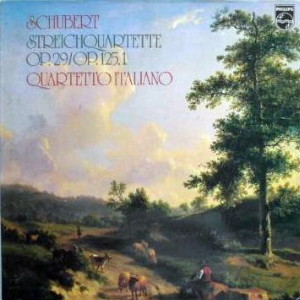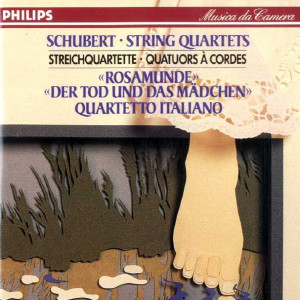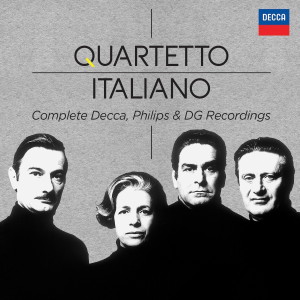 |
|
Philips
- 1 LP - 9500 078 - (p) 1977
|
 |
| Philips
- 1 CD - 426 383-2 - (c) 1990 |
 |
| Decca -
37 CDs - 478 8824 - (c) 2015 |
|
| Franz Schubert
(1797-1828) |
|
|
|
|
|
|
|
| String
Quartet No. 13 in A minor, Op. 29
(D 804) "Rosamunde" |
|
36' 50" |
|
-
Allegro ma non troppo
|
14' 26" |
|
|
-
Andante
|
8' 16" |
|
|
| -
Menuetto (Allegretto) |
6' 55" |
|
|
-
Allegro moderato
|
7' 13" |
|
|
|
|
|
|
| String
Quartet No. 10 in E flat major,
Op. 125 No. 1 (D 87) |
|
26' 56" |
|
-
Allegro moderato
|
9' 35" |
|
|
-
Scherzo (Prestissimo)
|
2' 09" |
|
|
| -
Adagio |
7' 27" |
|
|
| -
Allegro |
8' 17" |
|
|
|
|
|
|
QUARTETTO ITALIANO
- Paolo Borciani, Elisa Pegreffi, violino
- Piero Farulli,
viola
- Franco Rossi, violoncello
|
|
|
|
|
|
Luogo e data
di registrazione |
|
Musica
Théâtre
Salle
de Musique, La
Chaux-de-Fonds
(Svizzera)
- 5-28
gennaio 1976 |
|
|
Registrazione: live
/ studio |
|
studio |
|
|
Producer / Engineer |
|
Vittorio
Negri | Tony
Buczynski |
|
|
Prima Edizione LP |
|
Philips | 9500
078 | 1
LP | (p) 1977
|
|
|
Prima Edizione CD |
|
Philips | 426 383-2
| 1 CD - 76'
34"
| (c) 1990 | ADD | (D 804)
Decca | 478
8824 | 37
CDs - (30°, 1-4) | (c) 2015 | ADD
| (D 87)
|
|
|
Note |
|
-
|
|
|
|
|
Only a few
specialists are in a
position to take a
comprehensive view of
Schubert's total output
in its almost
unfathomable profusion
(the catalogue drawn up
by Otto Erich
Deutsch comes to about
a third more numbers
than Köchel's
Mozart). The same is
also true of the
separate categories of
works - in fact, only
quite a small
proportion of the
songs, the chamber
music and the piano
music for two or four
hands is widely known.
The chamber music is
represented by the
last three string
quartets, the piano
trios, the string
quintet, and the
"Trout" Quintet. Even
with the symphonies
there is a tendency to
keep to the late
pieces. The clear
preference for the
"middle" and "late"
instrumental works,
which may perhaps be
contrasted with the
more uniform
acceptance of
Beethoven's work, is
at all events not
unreasonable, for the
later music
undoubtedly ranks a
good deal higher than
the instrumental works
of his boyhood: and
this is not just a
matter of "stylistic
development,"
but probably stems
from the fact that it
was only by way of
Schubert's
song-writing that he
found his own voice
for instrumental music
as well. Thus, for
instance, the song
"Gretchen am
Spinnrade," written in
1814 must be rated
altogether superior to
the contemporary
Second Symphony or the
D major and B flat
major String Quartets.
"Schubert
is now having a
fortnight of fasting
and staying at
home," wrote the
painter Moritz von
Schwind, a member
of Schubert's
circle, in a
letter to Franz
von Schober: "he
is extraordinarily
hungry and
composes
innumerable
quartets and German
dances and
variations "In the
space of a few
weeks closely
following the
music for
"Rosamunde" and
"Die Schöne
Müllerin,"
completed in
1823, he wrote -
to name only the
greatest
compositions -
the Flute
Variations on
"Trockne
Blumen," the two
String Quartets
in A minor (Op.
29) and D minor
("Death and the
Maiden"), and
the Octet, Op.
166.
The
Andante
of the String
Quartet in A
minor D.
804 is derived
from one of
the entr'actes
for Rosamunde,
Princess of
Cyprus," a
play by
Helmina von Chézy,
the poetess
whose
ineffable
libretti had
already spelt
doom for Weber
and his
"Euryanthe."
"Rosamunde,"
performed in
Vienna in
December 1823,
fell
victim to
devastating
criticism, and
so it is quite
understandable
that in order
to rescue the
enchanting
melody from
the entr'acte
Schubert
transferred it
to the quartet
written
shortly
afterwards.
(A variant of
the theme
turns up once
again in the
third of the
four piano
impromtus, Op.
142 of 1827).
It would
nevertheless
be a mistake
to speak in
terms of a
creative
frenzy in the
spring of
1824, for w
know from a
letter
Schubert wrote
to the painter
Kupelwieser in
Rome, that he
was in danger
of sinking
into a
resigned
melancholy:
"Every night,
when I go to
sleep, I hope
I shall not
wake up again,
and every
morning brings
me only the
troubles of
the day
before. My
days are so
endless and
friendless..."
One is
inclined to
feel that this
elegiae mood
was
transformed
into music in
the first
movement of
the A minor
Quartet.
"I
have been
trying my
hand," writes
Schubert in
the same
letter, "at
several
instrumental
pieces, for I
have composed
two
quartets...
and an octet,
and I want to
write another
quartet, for
my overriding
intention is
to prepare my
path in this
way for a
great
symphony." The
"great
symphony" was
simply the
standard work
which the
ambitious
composer had
to tackle and
which could
bring him
public
recognition -
this was
normal right
through the
nineteenth
century, from
Beethoven to
Mahler. And
Schubert had
not in fact
written a
"great
symphony" by
1824, for he
could not
count either
his early
works in this
form or the
"Unfinished" B
minor
Symphony. For
modern ears,
however, it is
actually the
two string
quartets of
1824 in A
minor and D
minor, which
are amongst
Schubert's
most personal
instrumental
compositions,
more so
perhaps than
the "Great C
major"
Symphony.
The
a minor String
Quartet was
performed in
March 1824 at
a concert
given by the
Society of
Friends of
Music, with
Ignaz
Schuppanzigh
as leader -
the only one
of Schubert's
quartets to
attain the
distinction of
a complete
public
performances
in his
lifetime. (It
was also the
only Schubert
quartet to be
published - by
a Viennese
firm in the
autumn of
1824.) The
press notices
were reserved:
the Viennese
"Allgemeine
Musikalische
Zeitung" felt
that one would
need. "to hear
[the
composition]
more often
before giving
a considered
judgement" (a
familiar theme
in reviews
which seek to
hide their own
anadequacy
under a
truism); and
the
correspondent
of the
"Leipziger
Blatt"
observed
rather
paltroisingly:
"Quartet No. 1
by Schubert:
not too had
for a first
effort."
(Nothing was
generally
known of the
existence of
earlier
quartets by
Schubert.) His
friend Moritz
von Schwind,
however, hit
upon a
description
still valid
today when he
wrote: "The
quartet by
Schubert was
performed,
rather slowly
in his
opinion, but
with great
purity and
tenderness. As
a whole it is
very gentle
but it has a
way of making
a melody stay
with one, as
in a song,
full of
feeling and
very
distinctive.".
Peter
Steiner
|
|
|